BMW MOTORRAD K 1200 S 2004 Rider's Manual (in English)
Manufacturer: BMW MOTORRAD, Model Year: 2004, Model line: K 1200 S, Model: BMW MOTORRAD K 1200 S 2004Pages: 162, PDF Size: 2.99 MB
Page 91 of 162
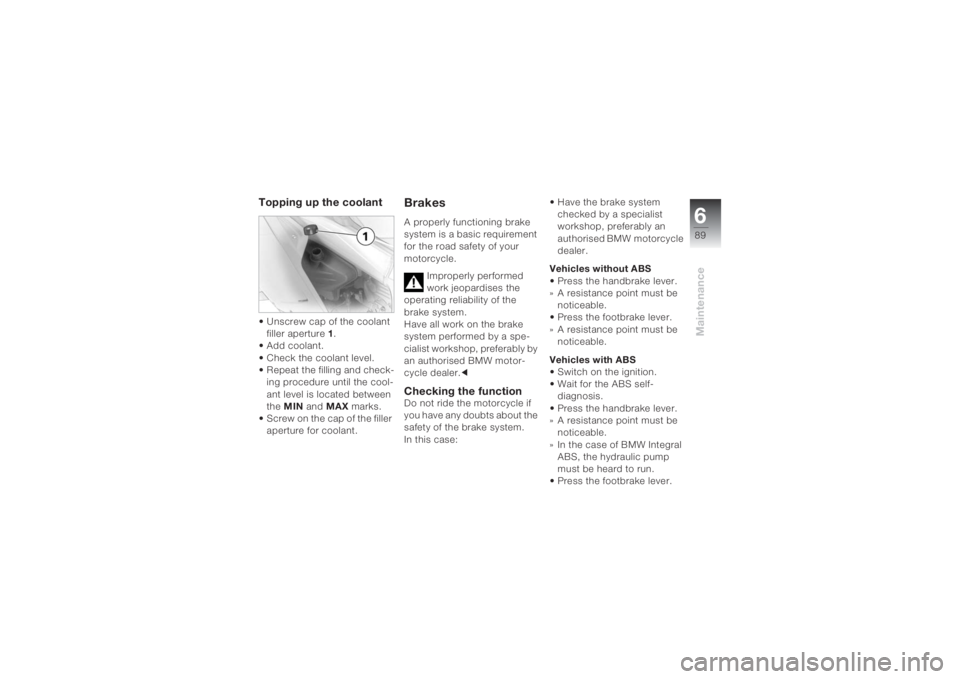
689Maintenance
Topping up the coolant • Unscrew cap of the coolant
filler aperture 1.
• Add coolant.
• Check the coolant level.
• Repeat the filling and check-
ing procedure until the cool-
ant level is located between
the MIN and MAX marks.
• Screw on the cap of the filler
aperture for coolant.
BrakesA properly functioning brake
system is a basic requirement
for the road safety of your
motorcycle.
Improperly performed
work jeopardises the
operating reliability of the
brake system.
Have all work on the brake
system performed by a spe-
cialist workshop, preferably by
an authorised BMW motor-
cycle dealer.cChecking the functionDo not ride the motorcycle if
you have any doubts about the
safety of the brake system.
In this case:• Have the brake system
checked by a specialist
workshop, preferably an
authorised BMW motorcycle
dealer.
Vehicles without ABS
• Press the handbrake lever.
» A resistance point must be
noticeable.
• Press the footbrake lever.
» A resistance point must be
noticeable.
Vehicles with ABS
• Switch on the ignition.
•Wait for the ABS self-
diagnosis.
• Press the handbrake lever.
» A resistance point must be
noticeable.
» In the case of BMW Integral
ABS, the hydraulic pump
must be heard to run.
• Press the footbrake lever.
Page 92 of 162
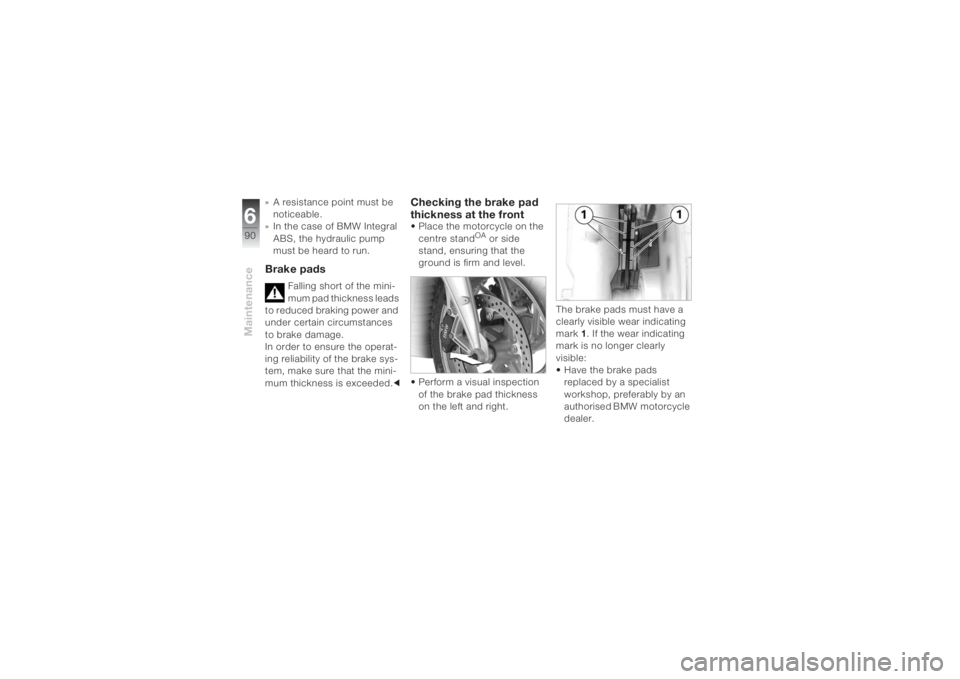
Maintenance690
» A resistance point must be
noticeable.
» In the case of BMW Integral
ABS, the hydraulic pump
must be heard to run.Brake pads
Falling short of the mini-
mum pad thickness leads
to reduced braking power and
under certain circumstances
to brake damage.
In order to ensure the operat-
ing reliability of the brake sys-
tem, make sure that the mini-
mum thickness is exceeded.c
Checking the brake pad
thickness at the front• Place the motorcycle on the
centre stand
OA or side
stand, ensuring that the
ground is firm and level.
• Perform a visual inspection
of the brake pad thickness
on the left and right.The brake pads must have a
clearly visible wear indicating
mark 1. If the wear indicating
mark is no longer clearly
visible:
• Have the brake pads
replaced by a specialist
workshop, preferably by an
authorised BMW motorcycle
dealer.
Page 93 of 162
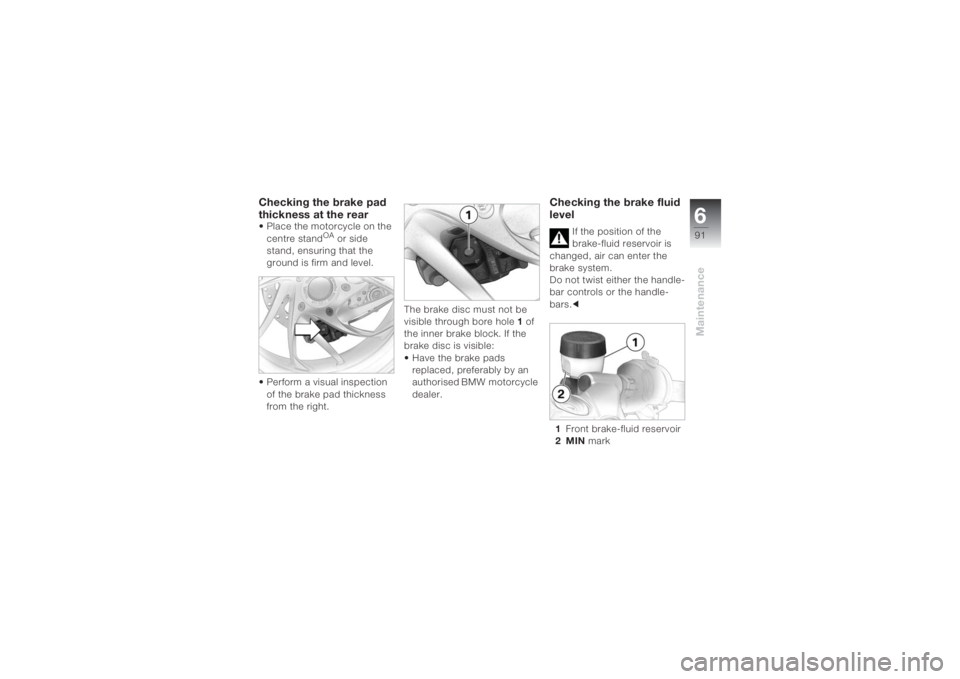
691Maintenance
Checking the brake pad
thickness at the rear• Place the motorcycle on the
centre stand
OA or side
stand, ensuring that the
ground is firm and level.
• Perform a visual inspection
of the brake pad thickness
from the right.The brake disc must not be
visible through bore hole 1 of
the inner brake block. If the
brake disc is visible:
• Have the brake pads
replaced, preferably by an
authorised BMW motorcycle
dealer.
Checking the brake fluid
level
If the position of the
brake-fluid reservoir is
changed, air can enter the
brake system.
Do not twist either the handle-
bar controls or the handle-
bars.c
1Front brake-fluid reservoir
2MIN mark
Page 94 of 162

Maintenance692
1Rear brake-fluid reservoir
2MIN mark
• Hold the motorcycle verti-
cally or place it on the centre
stand
OA, ensuring that the
ground is firm and level.
• Straight ahead handlebar
position.
• Read off the brake fluid level
at the reservoir.Vehicles without ABS
In the event of brake pad
wear, the brake fluid level
in the brake-fluid reservoir
falls.c
The brake fluid level must not
fall below the MIN mark. If the
brake fluid level falls below the
MIN mark:
If there is too little brake
fluid in the brake-fluid
reservoir, air can enter the
brake system. This causes a
serious reduction in braking
efficiency.
Brake carefully and safely.
Avoid braking sharply.c
• Have the fault remedied as
soon as possible by a spe-
cialist workshop, preferably
an authorised BMW motor-
cycle dealer.Vehicles with ABS
In the event of brake pad
wear, the brake fluid level
remains constant.c
If the brake fluid level falls -
even above the MIN mark -
this indicates a defect in the
brake system. If the brake fluid
level falls:
If there is too little brake
fluid in the brake-fluid
reservoir, air can enter the
brake system. This causes a
serious reduction in braking
efficiency.
Brake carefully and safely.
Avoid braking sharply.c
• Have the fault remedied as
soon as possible by a spe-
cialist workshop, preferably
an authorised BMW motor-
cycle dealer.
Page 95 of 162
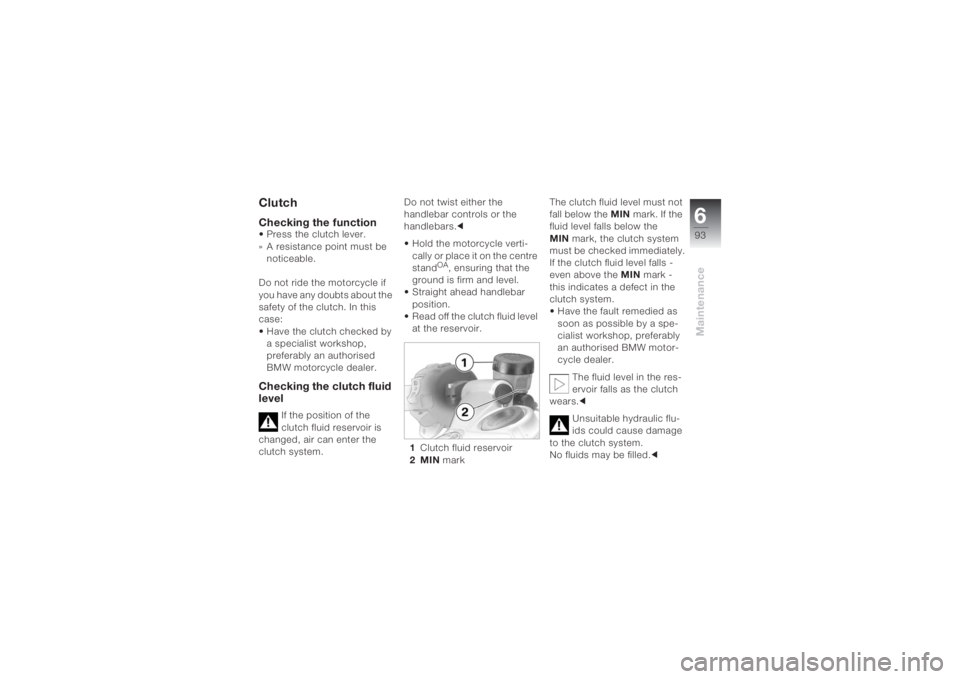
693Maintenance
ClutchChecking the function• Press the clutch lever.
» A resistance point must be
noticeable.
Do not ride the motorcycle if
you have any doubts about the
safety of the clutch. In this
case:
• Have the clutch checked by
a specialist workshop,
preferably an authorised
BMW motorcycle dealer.Checking the clutch fluid
level
If the position of the
clutch fluid reservoir is
changed, air can enter the
clutch system. Do not twist either the
handlebar controls or the
handlebars.c
• Hold the motorcycle verti-
cally or place it on the centre
stand
OA, ensuring that the
ground is firm and level.
• Straight ahead handlebar
position.
• Read off the clutch fluid level
at the reservoir.
1Clutch fluid reservoir
2MIN markThe clutch fluid level must not
fall below the MIN mark. If the
fluid level falls below the
MIN mark, the clutch system
must be checked immediately.
If the clutch fluid level falls -
even above the MIN mark -
this indicates a defect in the
clutch system.
• Have the fault remedied as
soon as possible by a spe-
cialist workshop, preferably
an authorised BMW motor-
cycle dealer.
The fluid level in the res-
ervoir falls as the clutch
wears.c
Unsuitable hydraulic flu-
ids could cause damage
to the clutch system.
No fluids may be filled.c
Page 96 of 162
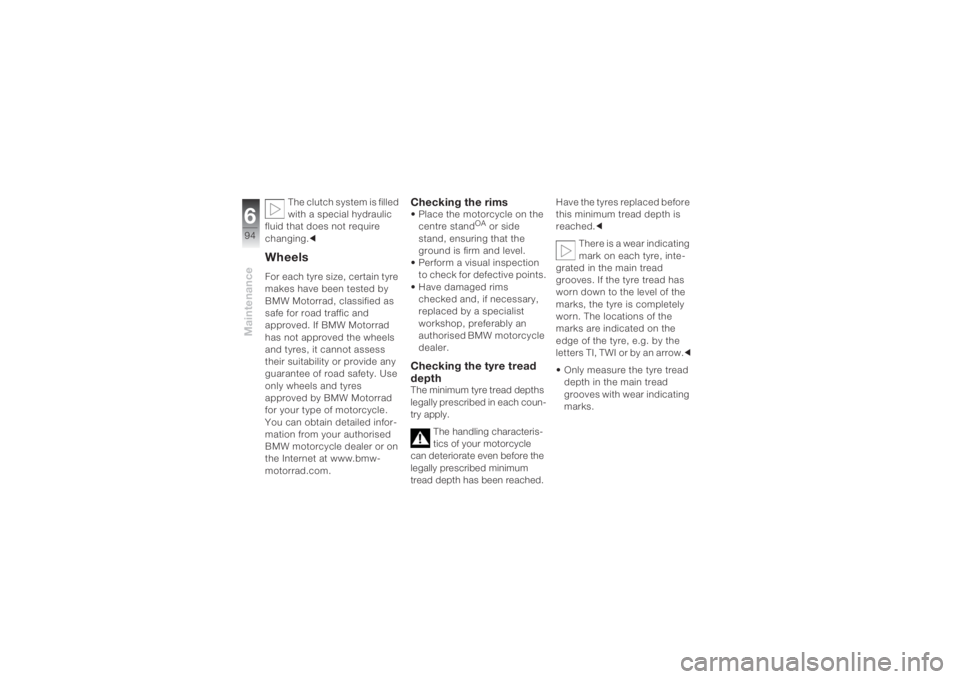
Maintenance694
The clutch system is filled
with a special hydraulic
fluid that does not require
changing.c
WheelsFor each tyre size, certain tyre
makes have been tested by
BMW Motorrad, classified as
safe for road traffic and
approved. If BMW Motorrad
has not approved the wheels
and tyres, it cannot assess
their suitability or provide any
guarantee of road safety. Use
only wheels and tyres
approved by BMW Motorrad
for your type of motorcycle.
You can obtain detailed infor-
mation from your authorised
BMW motorcycle dealer or on
the Internet at www.bmw-
motorrad.com.
Checking the rims• Place the motorcycle on the
centre stand
OA or side
stand, ensuring that the
ground is firm and level.
• Perform a visual inspection
to check for defective points.
• Have damaged rims
checked and, if necessary,
replaced by a specialist
workshop, preferably an
authorised BMW motorcycle
dealer.
Checking the tyre tread
depth The minimum tyre tread depths
legally prescribed in each coun-
try apply.
The handling characteris-
tics of your motorcycle
can deteriorate even before the
legally prescribed minimum
tread depth has been reached. Have the tyres replaced before
this minimum tread depth is
reached.c
There is a wear indicating
mark on each tyre, inte-
grated in the main tread
grooves. If the tyre tread has
worn down to the level of the
marks, the tyre is completely
worn. The locations of the
marks are indicated on the
edge of the tyre, e.g. by the
letters TI, TWI or by an arrow.c
• Only measure the tyre tread
depth in the main tread
grooves with wear indicating
marks.
Page 97 of 162
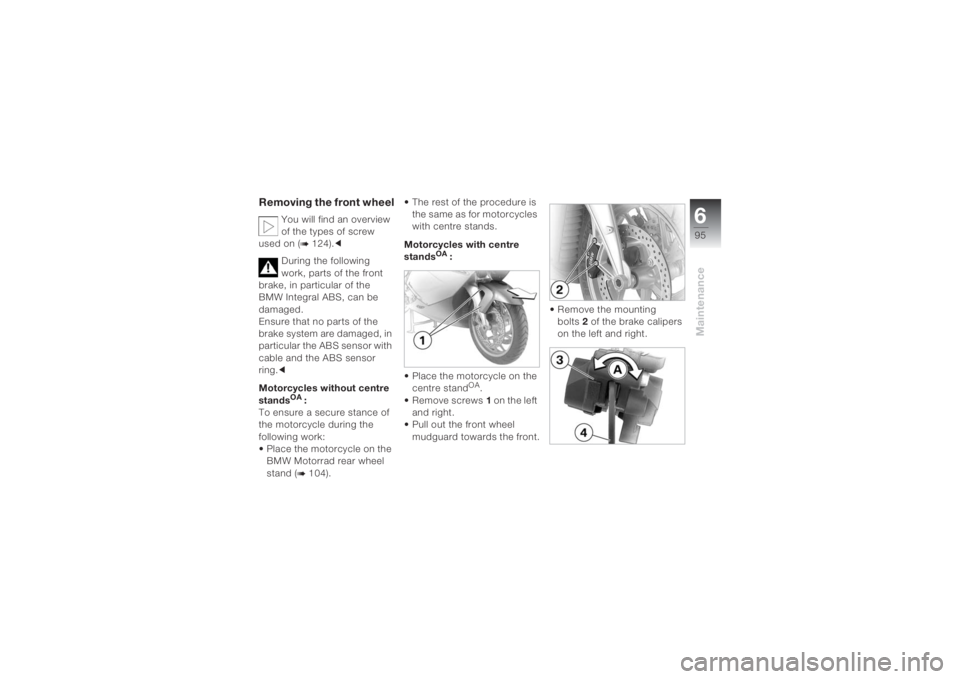
695Maintenance
Removing the front wheel
You will find an overview
of the types of screw
used on (
b 124).c
During the following
work, parts of the front
brake, in particular of the
BMW Integral ABS, can be
damaged.
Ensure that no parts of the
brake system are damaged, in
particular the ABS sensor with
cable and the ABS sensor
ring.c
Motorcycles without centre
stands
OA
:
To ensure a secure stance of
the motorcycle during the
following work:
• Place the motorcycle on the
BMW Motorrad rear wheel
stand (b 104). • The rest of the procedure is
the same as for motorcycles
with centre stands.
Motorcycles with centre
stands
OA
:
• Place the motorcycle on the
centre stand
OA.
• Remove screws1 on the left
and right.
• Pull out the front wheel
mudguard towards the front.• Remove the mounting
bolts2 of the brake calipers
on the left and right.
Page 98 of 162
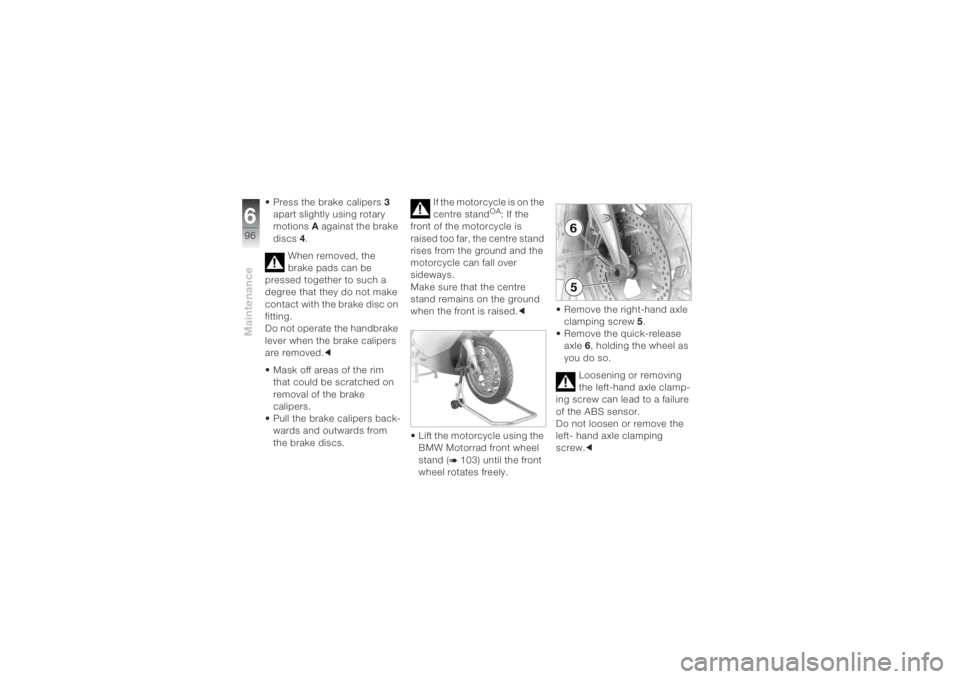
Maintenance696
• Press the brake calipers3
apart slightly using rotary
motionsA against the brake
discs4.
When removed, the
brake pads can be
pressed together to such a
degree that they do not make
contact with the brake disc on
fitting.
Do not operate the handbrake
lever when the brake calipers
are removed.c
• Mask off areas of the rim
that could be scratched on
removal of the brake
calipers.
• Pull the brake calipers back-
wards and outwards from
the brake discs. If the motorcycle is on the
centre stand
OA: If the
front of the motorcycle is
raised too far, the centre stand
rises from the ground and the
motorcycle can fall over
sideways.
Make sure that the centre
stand remains on the ground
when the front is raised.c
• Lift the motorcycle using the
BMW Motorrad front wheel
stand (
b 103) until the front
wheel rotates freely.• Remove the right-hand axle
clamping screw 5.
• Remove the quick-release
axle 6, holding the wheel as
you do so.
Loosening or removing
the left-hand axle clamp-
ing screw can lead to a failure
of the ABS sensor.
Do not loosen or remove the
left- hand axle clamping
screw.c
Page 99 of 162
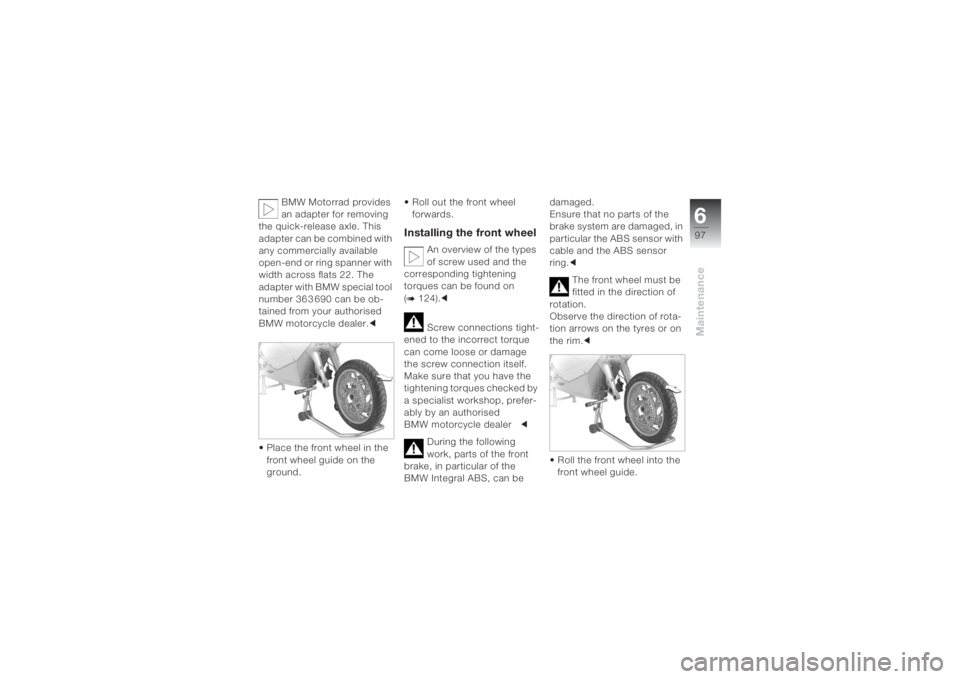
697Maintenance
BMW Motorrad provides
an adapter for removing
the quick-release axle. This
adapter can be combined with
any commercially available
open-end or ring spanner with
width across flats 22. The
adapter with BMW special tool
number 36 3 690 can be ob-
tained from your authorised
BMW motorcycle dealer.c
• Place the front wheel in the
front wheel guide on the
ground.• Roll out the front wheel
forwards.
Installing the front wheel
An overview of the types
of screw used and the
corresponding tightening
torques can be found on
(
b 124).c
Screw connections tight-
ened to the incorrect torque
can come loose or damage
the screw connection itself.
Make sure that you have the
tightening torques checked by
a specialist workshop, prefer-
ably by an authorised
BMW motorcycle dealerc
During the following
work, parts of the front
brake, in particular of the
BMW Integral ABS, can be damaged.
Ensure that no parts of the
brake system are damaged, in
particular the ABS sensor with
cable and the ABS sensor
ring.c
The front wheel must be
fitted in the direction of
rotation.
Observe the direction of rota-
tion arrows on the tyres or on
the rim.c
• Roll the front wheel into the
front wheel guide.
Page 100 of 162
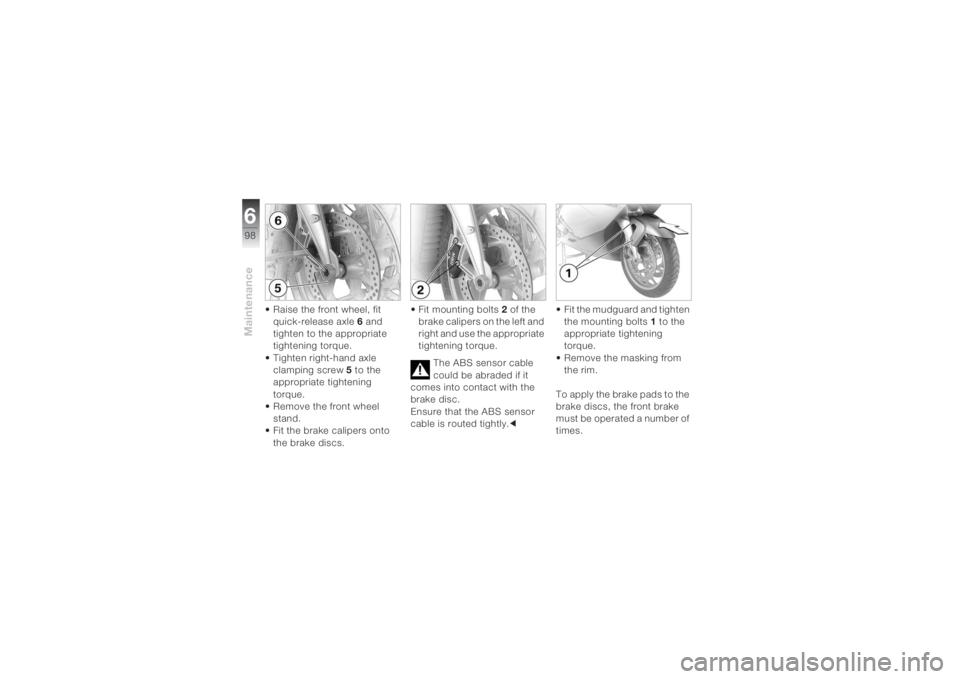
Maintenance698
• Raise the front wheel, fit
quick-release axle 6 and
tighten to the appropriate
tightening torque.
• Tighten right-hand axle
clamping screw 5 to the
appropriate tightening
torque.
• Remove the front wheel
stand.
• Fit the brake calipers onto
the brake discs.• Fit mounting bolts 2 of the
brake calipers on the left and
right and use the appropriate
tightening torque.
The ABS sensor cable
could be abraded if it
comes into contact with the
brake disc.
Ensure that the ABS sensor
cable is routed tightly.c• Fit the mudguard and tighten
the mounting bolts1 to the
appropriate tightening
torque.
• Remove the masking from
the rim.
To apply the brake pads to the
brake discs, the front brake
must be operated a number of
times.